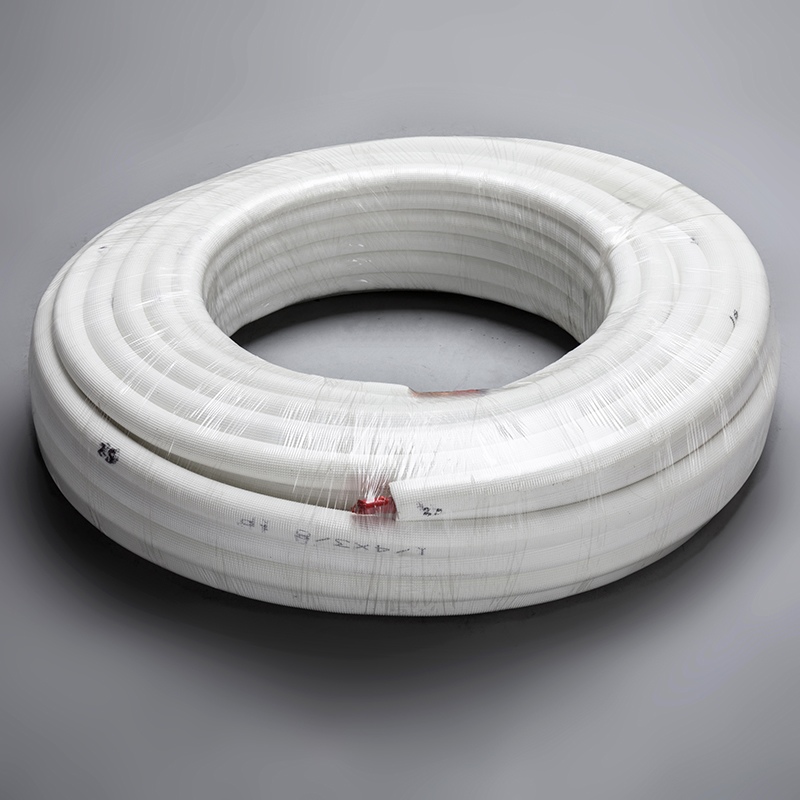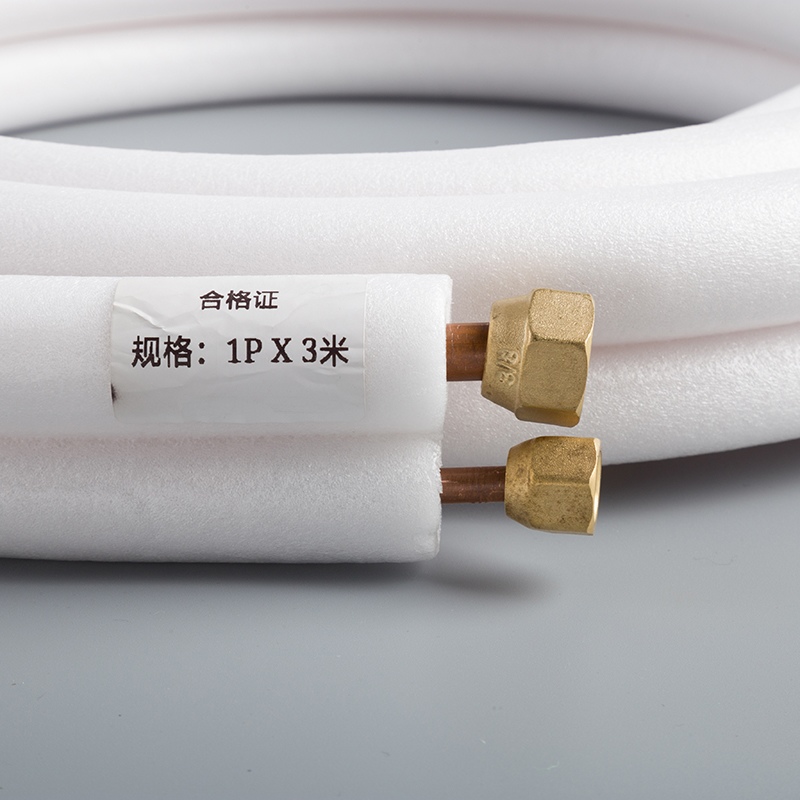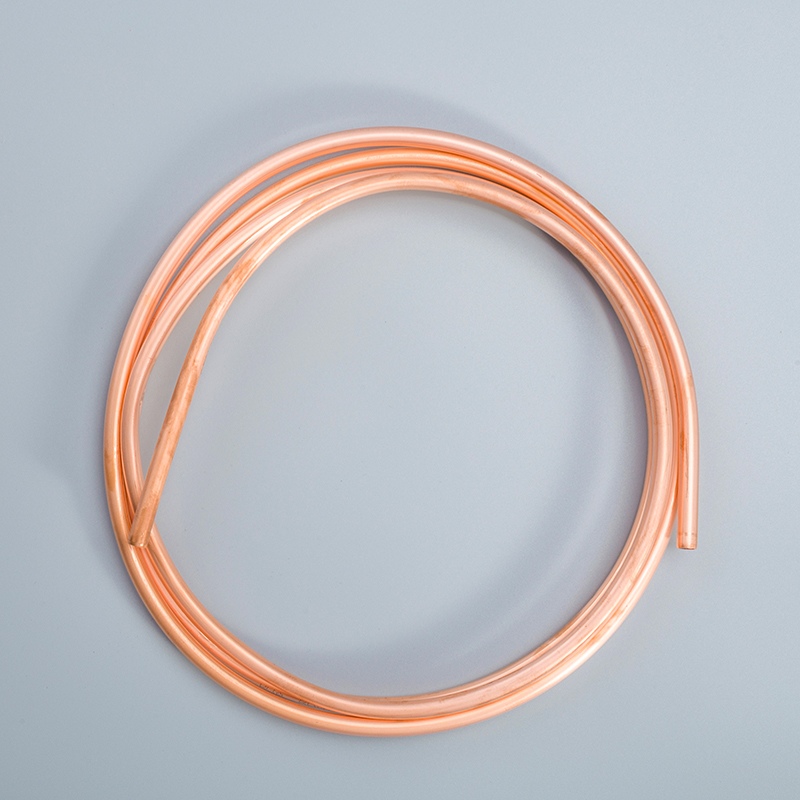How to Select the Best Copper Tubing for Air Conditioning

Copper pipes are key components of air conditioning systems. They facilitate the movement of refrigerant and the efficient transfer of heat. Copper is robust and conducts heat effectively, making it essential for HVAC systems. With the rise of urbanisation and increasing temperatures, more individuals require cooling solutions. This has led to a heightened demand for quality copper pipes, including wholesale copper tubing for air conditioning. The market for AC copper pipes is projected to expand from USD 5.2 billion in 2023 to USD 9.1 billion by 2032. Insulated copper pipes reduce heat loss from 3-5 BTUs to 1-2 BTUs per hour. Selecting the appropriate copper pipes involves considering quality, size, insulation, and pressure requirements.
Key Takeaways
Pick copper tubing with 99.9% purity for better heat transfer. Pure copper lasts longer and helps prevent leaks in systems.
Choose tubing size that fits refrigerant flow rates correctly. Right sizing stops damage and keeps cooling efficient.
Use copper tubing with insulation to save energy and money. Insulation keeps refrigerant cold and lowers electricity bills.
Make sure copper tubing follows rules like ASTM B280. Following standards ensures safety and works well in air conditioners.
Buy copper tubing in bulk for bigger projects to save money. Bulk buying keeps quality steady and reduces overall costs.
Material Quality
Why Pure Copper Matters (e.g., 99.9% purity)
When picking copper pipes for air conditioners, purity is key. Copper with 99.9% purity moves heat better, making cooling more effective. Impurities can make the copper weaker and less durable. Pure copper also fights rust, keeping your system working longer. Using high-quality copper pipes lowers the chance of leaks or breakdowns, giving you a reliable system.
Important Standards (e.g., ASTM B280, EN 12735)
Standards help ensure copper pipes are good for air conditioning. Some well-known standards include:
ASTM B280: Made for refrigeration-grade copper pipes used in HVAC systems.
EN 12735-1: Covers copper pipes for cooling and modern refrigerants.
JIS H3300: Gives rules for seamless copper and alloy pipes.
Standard | What It Covers |
|---|---|
ASTM B280 | Refrigeration-Grade Copper Pipes |
EN 12735-1 | Copper Pipes for Cooling and Refrigeration |
Following these standards ensures the pipes handle the pressures and heat of air conditioners.
Advantages of Good Copper Pipes for Long Use and Efficiency
Using top-quality copper pipes has many benefits. They make cooling systems work better by transferring heat efficiently. New ideas like MicroGroove technology use smaller pipes to improve refrigerant flow. This boosts heat transfer and saves material costs with thinner walls.
Good copper pipes last longer, so you replace them less often. For refrigerants like R290 and R32, thicker walls (15-20% more) are needed for higher pressure. Rules like Brazil’s INMETRO Ordinance 555 suggest microchannel pipes with 0.71mm walls for better cooling. Inner-grooved designs, like in China’s GB21455-2019, improve heat transfer and remove non-standard models.
Choosing high-quality copper pipes improves your cooling system, cuts repair costs, and meets global rules.
Size and Wall Thickness

Picking the Right Size for Your System
Choosing the right size of copper tubing is very important. If the tubing is too small, refrigerant moves too fast. This can cause problems like damage in suction lines over time. Tubing that is too big costs more and is harder to install. It also takes up extra space and uses more energy.
To find the correct size, check the refrigerant flow rate and speed. Engineers often use charts to match the tubing's outer diameter (OD) and wall thickness. This helps the system work well and avoids issues like friction or heat loss.
Tip: Always check your HVAC system's guide or ask an expert to pick the right pipe size.
Matching Tubing Size to Refrigerant Pressure
The size of copper tubing affects how refrigerant pressure works in the system. For example, a 15 mm tube might cause a big temperature drop. Switching to an 18 mm tube can fix this and improve cooling.
Pressure drops happen because of friction or height changes in the tubing. These drops affect the pressure at the expansion device, which is key for good performance. Correctly sized tubing keeps pressure and temperature steady throughout the system.
Reports show why these rules matter when designing refrigerant lines. They give useful advice on market trends and standards to help you choose the right tubing size.
How Wall Thickness Affects Strength and Pressure
Wall thickness is important for how strong and pressure-resistant copper tubing is. Thicker walls handle higher pressures, which is great for modern refrigerants like R32. But thicker tubing costs more and is harder to install.
Thin walls are cheaper but may not be strong enough for high-pressure systems. It's important to balance cost and performance. The right wall thickness ensures the tubing works safely and efficiently under system conditions.
Note: Always think about the refrigerant type and system pressure when picking tubing. This helps you choose the right thickness for long-lasting performance.
Insulation

Benefits of Insulated Copper Tubing for Energy Efficiency
Insulated copper tubes help air conditioners save energy. They stop heat from moving between the refrigerant and the outside air. This keeps the refrigerant at the right temperature inside the tubes. Less energy is wasted, so the system works better. Using insulated copper tubes lowers electricity costs and helps the environment.
Insulation also stops the refrigerant from getting too hot or cold. This keeps the cooling process steady and improves how well the air conditioner works. Insulated copper tubes are a smart choice for saving money and boosting efficiency over time.
Reducing BTU Loss and Preventing Condensation
Insulated copper tubes cut down on BTU loss. BTU loss means heat energy escapes during operation. Without insulation, heat leaks out, making the system less efficient and using more energy. Insulation acts like a shield, keeping the refrigerant at the right temperature and stopping heat from escaping.
Condensation happens when warm air touches cold copper pipes. This creates water droplets that can cause damage. Insulated copper tubes stop this by keeping the pipe surface temperature steady. This prevents rust and helps your air conditioner last longer.
Factor | Description |
|---|---|
Ambient Temperature | Cooler air makes pipes lose heat faster, affecting freezing time. |
Pipe Size | Bigger pipes hold more heat, changing how fast they freeze. |
Fluid Temperature | The fluid’s heat affects how quickly pipes freeze. |
Insulation Thickness | Thicker insulation slows heat loss, delaying freezing. |
Wind Speed | Strong winds make pipes freeze faster by cooling them. |
Pipe Material | Materials like copper and PVC freeze at different speeds. |
Heat Trace Systems | These systems work with insulation to keep pipes warm longer. |
Types of Insulation Materials and Their Applications
Different insulation materials work for various needs. Foam insulation is light and simple to install, making it great for homes. Rubber insulation bends easily and lasts long, so it’s good for businesses with changing temperatures. Fibreglass insulation handles extreme heat and cold, making it perfect for factories.
When choosing insulation, think about temperature limits, water resistance, and how easy it is to install. Insulated copper tubes help air conditioners work better and last longer.
Standards Compliance
Why Following Industry Standards Matters
Industry standards keep air conditioning systems safe and working well. They set rules for copper tubing quality and performance. This helps prevent problems like leaks or system breakdowns. Choosing copper tubing that meets these standards ensures your system works reliably in different conditions.
Standards also make parts easier to match and use together. Tubing that follows industry rules can safely handle refrigerant pressures and temperatures. This lowers risks and helps the system last longer without issues.
Important Standards to Check (e.g., AS/NZS 1571)
When picking copper tubing, check if it meets key standards. One example is AS/NZS 1571, which covers seamless copper tubes for cooling systems. It ensures the tubing can handle the pressures and heat of modern refrigerants.
The Crane Copper guide explains AS/NZS 1571 rules for seamless copper tubes used in cooling systems.
The Refrigerant Handling Code says all pipes must follow AS/NZS 1571:1995 for safe use and setup.
Other standards like ASTM B280 and EN 12735 are also important. These focus on copper tubing for refrigeration and refrigerant compatibility. Tubing that meets these rules ensures global safety and good performance.
Matching Tubing to Refrigerants and System Needs
Copper tubing must work with the refrigerants and conditions of your system. New refrigerants like R32 and R410A need tubing that handles higher pressures. Standards like AS/NZS 1571 ensure the tubing fits these refrigerants, avoiding leaks or inefficiencies.
Think about your system’s specific needs too. Factors like refrigerant type, pressure, and temperature affect tubing choice. Tubing that meets industry rules works safely and efficiently in these conditions.
Performance and Durability
How Copper Tubing Improves Cooling and System Efficiency
Copper tubing helps air conditioners work better. It moves heat quickly, which is important for cooling. For example, C12200 copper tubing transfers heat well, even if it’s not as good as pure copper.
Smaller tubes with thinner walls are often used in heat exchangers. These designs save material and improve refrigerant flow. Inner grooves inside the tubes make heat transfer even faster. Choosing copper pipes with these features can save energy and lower running costs.
Lifespan and Maintenance Tips
Copper tubing is strong but needs care to last long. It can work for 10 to 25 years if kept in good condition. Cleaning and checking the pipes regularly stops rust and blockages. Ignoring maintenance can cause expensive problems.
Getting the pipes installed by experts is very important. Bad installation can lead to leaks and make the system less effective. Extreme weather can also affect how long the pipes last. Refrigeration-grade copper is made to handle tough conditions, making it a better choice for long-term use.
Picking Tubing for Reliable Performance
Choosing the right copper tubing keeps your air conditioner working well for years. Good-quality copper resists rust and lasts longer, even in harsh places. Refrigeration copper is made for air conditioners and handles high pressure and temperature changes.
Plumbing copper works for mild conditions but isn’t as reliable for air conditioners. Pick tubing that fits your system’s needs and where it will be installed. Using quality materials and hiring professionals for installation reduces repairs and keeps your system efficient.
Factor | Details |
|---|---|
Lifespan | Lasts 10–25 years with good care and proper conditions. |
Maintenance | Regular cleaning and checks prevent damage and extend life. |
Installation | Expert installation avoids leaks and improves durability. |
Environmental Conditions | Tough weather can shorten life; refrigeration copper works better in such cases. |
Quality of Material | High-grade copper lasts longer and performs better. |
Tip: Use copper tubing with grooves and thin walls for better cooling. Always hire professionals for installation to ensure long-lasting performance.
Additional Considerations
Refrigerant Pressure Needs
Refrigerant pressure is important when picking copper tubing. Air conditioners work under specific pressures, and the tubing must handle them safely. Engineers check the pressure ratings of tubes, fittings, and joints together. The weakest part decides the maximum pressure the system can handle.
Soldered and brazed joints often limit the system's pressure because of their strength ratings. Copper tubing is safer because its burst pressure is much higher than its working pressure. This gives extra safety and reliability over time. When choosing tubing, think about the refrigerant type and its pressure needs. Modern refrigerants like R32 need tubing that handles higher pressures. Working with engineers helps ensure the tubing fits these needs and keeps the system efficient.
How Installation Environment Affects Tubing Choice
Where the air conditioner is installed affects the tubing choice. Outdoor systems face weather changes like heat, cold, and humidity. These can cause rust or lower performance if the tubing isn’t made for tough conditions.
Indoor systems may have limited space or hard-to-reach areas. Flexible tubing works better in tight spaces, while rigid tubing fits open areas. Chemicals or pollution in the environment can also damage the tubing faster. Choosing copper tubing that resists rust and wear helps it last longer and reduces repairs in harsh conditions.
Balancing Budget and Quality
Budget limits often affect which copper tubing you pick. Imported copper tubes are more expensive due to tariffs, making buying harder. Some buyers, like hospitals, adjust their choices to meet budgets while keeping quality standards.
To save money, you can buy in bulk or from local suppliers. Wholesale copper tubing is cheaper for big projects. But always focus on quality over cost. Cheap tubing might save money now but could lead to costly repairs later. High-quality copper tubing lasts longer and works better, making it a smarter choice for your air conditioner.
Ease of Installation and Handling
Setting up copper tubing for air conditioners can be simple. Picking the right type and using proper methods makes it easier. Factors like flexibility, weight, and fitting compatibility affect installation ease.
Factors That Make Installation Easier
Flexibility: Flexible tubing bends easily for tight spaces or tricky layouts. It’s simple to move without special tools, saving time.
Lightweight Design: Lightweight tubing is easy to carry and install. It’s helpful for overhead or vertical setups, reducing effort.
Standardised Fittings: Tubing that fits standard connectors ensures secure joints. This lowers leak risks and makes assembly quicker.
Tips for Handling Copper Tubing
Tip: Wear gloves when handling copper tubing. Gloves stop scratches and keep dirt off the tubing.
Don’t bend tubing too sharply. Sharp bends can weaken it and cause cracks.
Use a tube cutter for neat cuts. Clean ends fit better into connectors.
Store tubing in a dry place to avoid damage before use.
Tools That Simplify Installation
Tool | Purpose |
|---|---|
Tube Cutter | Makes smooth, clean cuts. |
Bending Spring | Helps bend tubing without damage. |
Flaring Tool | Shapes tubing ends for fittings. |
Deburring Tool | Removes sharp edges after cutting. |
Using the right tools ensures neat work and fewer mistakes during installation.
Why Proper Handling Matters
Handling copper tubing carefully helps it last longer. Damage like dents or scratches can cause leaks and lower performance. Following good practices keeps the tubing strong and efficient for years.
Note: High-quality tubing and tools make installation easier and reduce future repair costs.
Wholesale Copper Tubing for Air Conditioning
Why Buying in Bulk is Smart for Big Projects
Buying wholesale copper tubing has many benefits for big projects. Bulk buying ensures you have enough materials, avoiding delays during work. This is very helpful for large jobs where time is important.
It also helps keep the quality of tubing the same everywhere. Using one type of tubing makes maintenance easier and performance consistent. For example, if you’re installing HVAC systems in many buildings, buying from one source saves time and effort.
Tip: Work out how much tubing you need before ordering. This avoids buying too much and wasting money.
Checking Quality and Standards When Buying Wholesale
When buying wholesale copper tubing, always focus on quality. Poor-quality tubing can cause leaks, waste energy, and cost more to fix. Make sure the tubing meets standards like ASTM B280 or EN 12735. These rules ensure the tubing works well under air conditioning pressures and temperatures.
Ask the supplier for proof of quality, like certificates or test results. Check the tubing for dents or rough surfaces. Good tubing should be smooth and evenly thick.
Note: Choosing a trusted supplier lowers the chance of getting bad materials.
Saving Money and Picking the Right Supplier
Buying wholesale copper tubing can save a lot of money. Bulk orders often mean lower prices per unit. This is great for contractors handling big projects. But don’t let low prices mean poor quality.
Pick a supplier with a good reputation and reliable service. They should offer fair prices without lowering standards. Look for suppliers who deliver on time and provide good support. Comparing suppliers helps you find the best mix of cost and quality.
Tip: Choose suppliers that give warranties for their tubing. This protects your investment and gives peace of mind.
Choosing the right copper tubing for air conditioning is important. Think about material quality, size, insulation, standards, and performance. Good-quality tubing lasts longer and works efficiently. It also ensures your system runs smoothly and reliably.
Pick tubing that follows industry rules and fits your system’s needs. Check if it handles refrigerant pressure and suits the installation area. Ask experts for advice and ensure it meets eco-friendly building codes. Copper is durable and resists bacteria, making it great for HVAC and water systems. Big infrastructure projects show how copper improves efficiency and sustainability.
Tip: Use energy-saving tubing to lower costs and help the environment.
FAQ
What does copper tubing do in HVAC systems?
Copper tubing moves refrigerant and heat in HVAC systems. It helps keep cooling and heating efficient by controlling pressure and temperature. Its strength and rust resistance make it great for long-term use.
How can you pick the right size of copper tubing?
Choose tubing that matches your system’s refrigerant flow and pressure needs. Wrong sizes can cause problems or damage. Check your system’s manual or ask an expert for advice.
Why is insulation needed for copper tubing?
Insulation stops heat loss and prevents condensation. It keeps refrigerant temperatures steady, saving energy and lowering electricity bills. Insulated tubing also fights rust and makes your system last longer.
What rules should copper tubing follow for air conditioning?
Copper tubing must meet standards like ASTM B280 or EN 12735. These ensure it handles refrigerant pressures and temperatures safely. Standards also make it work well with modern refrigerants.
Can buying copper tubing in bulk save money?
Buying in bulk lowers the cost per unit, which is good for big projects. Make sure the tubing meets quality standards to avoid costly repairs later. Pick a trusted supplier for good quality and on-time delivery.
See Also
The Advantages of Selecting Copper Pipes for Air Conditioning
Exploring the Development of Copper Tubing in Air Conditioning
Comparing Efficiency: Copper Tubes Against Aluminium in Air Conditioning
Examining the Role of Copper Tubing in Air Conditioning Systems
The Importance of Pure Copper Pipes for Effective Air Conditioning


